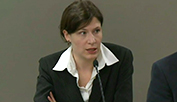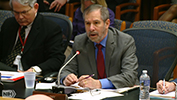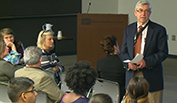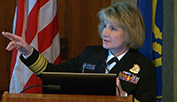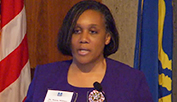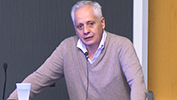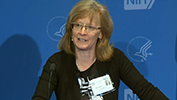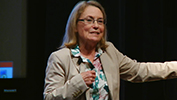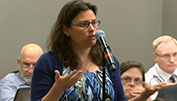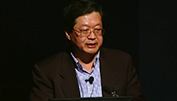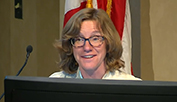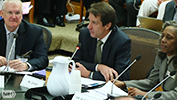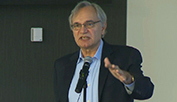-
- NIH VideoCast - Demystifying Medicine 2017: Current Infectious Disease Challenges
-
- - David M. Morens, MD, NIAID, NIH (2017/05/18)
- - Category : Demystifying Medicine
- The Demystifying Medicine Lecture Series is designed to help bridge the gap between advances in biology and their applications to major human diseases. Each lecture will feature a presentation on a major disease, including current research and advancements on treatments.
For more information go to https://demystifyingmedicine.od.nih.gov
NIH VideoCast - Demystifying Medicine 2017: Current Infectious Disease Challenges
-
- NIH VideoCast - On the role of rat superior colliculus in cognitive control
-
- - Carlos D. Brody, Ph.D., Professor, Department of Molecular Biology, Princeton University (2017/05/17)
- - Category : Neuroscience
- NIH Neuroscience Series Seminar
Dr. Brody???s lab uses a combination of computational, behavioral, and electrophysiological techniques. They train rats to perform tasks that require cognitive components that they are interested in studying. For example, they train them to remember a stimulus for a few seconds, and to then make a behavior based on their memory of the stimulus. They can then study neural responses during this behavior, and observe the neural correlates of short-term memory. To help them understand the mechanisms behind their findings, they build computational models of networks of spiking neurons, with which they explore the circuit architectures and mechanistic hypotheses that could explain the experimental results. The models both give them greater insight into potential mechanisms, and help them decide what are the best next experiments to test and distinguish between hypotheses.
Currently they are focused on three behavioral tasks performed by rats, all studied from the combined computational/experimental approach. The first is a task in which rats are presented with a first stimulus; then there is a pause; then they are presented with a second stimulus; and the rats must compare the two stimuli and make a binary decision based on the comparison. They use this task to study short-term memory and decision-making. In the second task, they study how it is that cognitive state can flexibly determine appropriate rules of behavior. The third task that they are working on is one where rats hear a sound, and must decide whether the sound was long or short. They are using this task to study the neural basis of time perception. But where in the brain is information about time processed and perceived? And how is time represented? These are some of the questions they are addressing with their time discrimination task.
For more information go to https://neuroscience.nih.gov/neuroseries/Home.aspx
NIH VideoCast - On the role of rat superior colliculus in cognitive control
-
- NIH VideoCast - Optimizing the Investment in Medical Devices for Rehabilitation (Day 2)
-
- - NIH (2017/05/13)
- - Category : Conferences
- To convene stakeholders to determine best methods to work with investigators developing devices and assistive technologies for the medical rehabilitation market to clear regulatory and payer hurdles for market entry and successful commercialization. The theme of the workshop is to identify success stories of rehabilitation devices that have entered the market for clinical application or for direct use by the individual with disability. The group will identify needed resources, infrastructure, and information needed to build on these successes and identify avenues for dissemination of these throughout the research community.
NIH VideoCast - Optimizing the Investment in Medical Devices for Rehabilitation (Day 2)
-
- NIH VideoCast - Frederick National Laboratory Advisory Committee (FNLAC) - May 2017
-
- - NCI, NIH (2017/05/13)
- - Category : Advisory Board Meetings and Workshops
- The 12th meeting of the Frederick National Laboratory Advisory Committee
NIH VideoCast - Frederick National Laboratory Advisory Committee (FNLAC) - May 2017
-
- NIH VideoCast - NINDS Fellows Responsible Conduct of Research Training
-
- - Alan Koretsky, Scientific Director, NINDS, NIH (2017/05/13)
- - Category : Special
- Responsible Conduct of Research Training for all NINDS Post Doctoral trainees.
NIH VideoCast - NINDS Fellows Responsible Conduct of Research Training
-
- NIH VideoCast - NLM Board of Regents Meeting (Day 1)
-
- - NLM, NIH (2017/05/13)
- - Category : Advisory Board Meetings and Workshops
- NLM Advisory Council Meeting
For more information go to https://www.nlm.nih.gov/od/bor/bor.html
NIH VideoCast - NLM Board of Regents Meeting (Day 1)
-
- NIH VideoCast - NLM Board of Regents Meeting (Day 2)
-
- - NLM, NIH (2017/05/13)
- - Category : Advisory Board Meetings and Workshops
- NLM Advisory Council Meeting
For more information go to https://www.nlm.nih.gov/od/bor/bor.html
NIH VideoCast - NLM Board of Regents Meeting (Day 2)
-
- NIH VideoCast - The Contribution of Bone to Whole Organism Physiology
-
- - Gerard Karsenty, M.D., Ph.D., Professor and Chair, Department of Genetics and Development, Columbia University Medical Center (2017/05/13)
- - Category : Geroscience
- GeroScience Interest Group
The Trans-NIH GeroScience Interest Group (GSIG), cordially invites you to its spring seminar, featuring Dr. Gerard Karsenty, the Paul A. Marks M.D., Professor and Chair of the Department of Genetics and Development at Columbia University Medical Center, New York City.
Dr. Karsenty`s main interest is how organs interact with one another to regulate vertebrates` various physiological functions. His research focuses on bone and, through the use of genetics, he has discovered that this organ, in addition to making bone, has remarkable endocrine functions that include the regulation of insulin secretion, glucose homeostasis, adaptation to exercise, testosterone production and male fertility, synthesis of neurotransmitters and cognitive functions. His laboratory has also identified a receptor for osteocalcin in muscle, testes and pancreas, which has prompted investigation into a possible novel function of osteocalcin.
The GSIG was created to discuss and explore the complex relationships between the biology of aging and the biology of diseases and conditions that are of interest to various institutes and centers across the NIH.
For more information go to http://sigs.nih.gov/geroscience/Pages/default.aspx
NIH VideoCast - The Contribution of Bone to Whole Organism Physiology
-
- NIH VideoCast - CC Grand Rounds: Contemporary Clinical Medicine: Great Teachers: Atopic Dermatitis: A Disease Mediated by Barrier or Immune Defects?
-
- - Lisa A. Beck, MD, Deans Professor of Dermatology and Medicine, University of Rochester Medical Center (2017/05/12)
- - Category : Clinical Center Grand Rounds
- CC Grand Rounds
Contemporary Clinical Medicine: Great Teachers: Atopic Dermatitis: A Disease Mediated by Barrier or Immune Defects?
For more information go to http://www.cc.nih.gov/about/news/grcurrent.html
NIH VideoCast - CC Grand Rounds: Contemporary Clinical Medicine: Great Teachers: Atopic Dermatitis: A Disease Mediated by Barrier or Immune Defects?
-
- NIH VideoCast - Extracellular vesicles released by glioblastoma cells: saboteurs, biomarkers and therapeutics
-
- - Xandra O. Breakefield, Ph.D., Professor of Neurology, Harvard Medical School Geneticist of Neurology, Massachusetts General Hospital (2017/05/12)
- - Category : WALS - Wednesday Afternoon Lectures
- NIH Director`s Wednesday Afternoon Lecture Series
Xandra Breakefield, Ph.D. is a basic scientist with a strong background in molecular genetics and neuroscience. She focuses her research efforts on: gene therapy for neurologic diseases; and elucidation of the role of extracellular vesicles (EVs) released from cancer cells in tumor progression. She led early studies demonstrating mutant RNA in serum EVs from glioblastoma patients as biomarkers.
Professor Breakefield has received a number of awards for her work, including a McKnight Foundation Neuroscience Development Award, two Javits Neuroscience Investigator Awards, the Society for Neuroscience Mika Salpeter Lifetime Achievement Award, and the Harvard Medical School William Silen Lifetime Achievement Mentoring Award. She is a member of the National Academy of Arts and Sciences and past president of the American Society of Gene and Cell Therapy.
For more information go to https://oir.nih.gov/wals/2016-2017/extracellular-vesicles-released-glioblastoma-cells-saboteurs-biomarkers
NIH VideoCast - Extracellular vesicles released by glioblastoma cells: saboteurs, biomarkers and therapeutics
-
- NIH VideoCast - Epithelial molecules shaping immunosurveillance by local T cells
-
- - Adrian Clive Hayday, FMedSci FRS, Glendinning Professor and Chair, Department of Immunobiology, King`s College London, Group leader at the Francis Crick Institute, UK (2017/05/12)
- - Category : Immunology
- Immunology Interest Group Seminar Series
The thesis of conventional immunology is centralized control whereby responses to infection within tissues are decided within lymph nodes, from which effector T lymphocytes are dispatched to quell regional disturbances. But this cannot explain the observation that many tissues at steady state are T cell-rich. Do such cells simply provide responses to infection or do they provide more generalized means to sustain tissue integrity and organ function? Likewise, how are such cells able to respond to acute stress but not drive constitutive tissue inflammation? And, how do immune cell???tissue interactions relate to organ physiology? To approach these questions, we have employed molecular genetics to identify key receptor-ligand axes that tissues use to communicate with their local T cell compartments at rest, upon infection and upon non-infectious dysregulation. These axes show how epithelial cells in the thymus and at body surfaces selectively educate specific T cell subtypes, thereby establishing the organ-specific composition and activities of local T cells. The molecules mediating epithelial control over tissue T cell immunity are implicated in inflammatory disease and cancer and offer hope for highly localized clinical regulation.
Adrian Hayday was trained in biochemistry at Cambridge, and obtained a PhD in molecular virology from London University. He began studying immunology in 1982 at MIT, where he and his colleagues first described the wholly unanticipated T cell receptor gamma chain genes. Since then Professor Hayday has used many parameters to establish that gamma delta T cells are clearly distinct from conventional T cells. Those parameters include the cells??? responses to different products of a novel gene family expressed at body surfaces, that Professor Hayday and his colleagues identified. He showed that this unique biology allows gamma-delta T cells to make rapid responses to tissue dysreguation, rather than to specific pathogens, and thereby to monitor tissue integrity. This may explain Professor Hayday???s observation that gamma delta T cell deficiency is associated with a profound susceptibility to skin carcinogens, findings that were instrumental in promoting his and others??? ongoing interest in the cells??? clinical application. In other clinical activities, he directed a team describing the human immune response to vaccination; and he described the unique properties of human autoantibodies harboured by individuals with deficiencies in T cell tolerance. Additionally, he is the lead-investigator of a Wellcome Trust-supported, multi-centre, high-throughput phenotyping screen identifying novel genetic regulators of the immune system.
Professor Hayday has authored over 200 papers, of which he is first, last, or corresponding author on over 120, and of which 150 are original research contributions. He has received many awards, including the William Clyde deVane Medal, Yale College???s highest honour for scholarship and teaching, an honorary fellowship of King???s College London, and the King???s College Business Award, 2008. He was elected to lead the British Society of Immunology (2005-09) and has organized many scientific meetings including the 2014 Gordon Conference in Immunochemistry and Immunobiology, and the scientific programme for the 2012 European Congress of Immunology. He is an elected fellow of the Academy of Medical Sciences and of the Royal Society.
He has formally advised many institutions including Institut Pasteur; the Max Planck Institute; Kyoto University, and the Wellcome Trust, and Cancer Research UK, whose respective funding committees he chaired for three years. He has participated in many aspects of the biotech/pharmaceutical sector, including membership of the MedImmune SAB, and was a co-founder of ImmunoQure AG before co-founding GammaDelta Therapeutics in 2016.
NIH VideoCast - Epithelial molecules shaping immunosurveillance by local T cells
-
- NIH VideoCast - Optimizing the Investment in Medical Devices for Rehabilitation (Day 1)
-
- - NIH (2017/05/11)
- - Category : Conferences
- To convene stakeholders to determine best methods to work with investigators developing devices and assistive technologies for the medical rehabilitation market to clear regulatory and payer hurdles for market entry and successful commercialization. The theme of the workshop is to identify success stories of rehabilitation devices that have entered the market for clinical application or for direct use by the individual with disability. The group will identify needed resources, infrastructure, and information needed to build on these successes and identify avenues for dissemination of these throughout the research community.
NIH VideoCast - Optimizing the Investment in Medical Devices for Rehabilitation (Day 1)
-
- NIH VideoCast - Getting to an Effective HIV Vaccine: Perspectives on Progress
-
- - Larry Corey, MD, HIV Vaccine Trials Network (2017/05/11)
- - Category : James C. Hill - HIV/AIDS Research
- James C. Hill Memorial Lecture
Virologist and vaccine expert Dr. Lawrence Corey will deliver the 2017 James C. Hill Memorial Lecture. His talk, titled ???Getting to an Effective HIV Vaccine: Perspectives on Progress,??? will review the state of HIV vaccine development and describe current strategies to advance the field.
Since 1999, Corey has served as principal investigator of the NIAID-supported HIV Vaccine Trials Network (HVTN), which is dedicated to accelerating development of a safe and effective preventive HIV vaccine. The HVTN has built an international scientific collaboration of investigators in 12 countries on 5 continents.
Corey will discuss recent advances in identifying and manufacturing broadly neutralizing antibodies that target multiple, diverse HIV strains. Researchers are testing whether???and to what extent???infusions of these antibodies can protect people from HIV infection to help inform the design of novel vaccine candidates.
He also will explain how HIV vaccinology is at an important crossroads in defining whether protective non-neutralizing antibodies can be elicited with a vaccine. He will describe ongoing clinical trials in humans that aim to build on vaccine regimens that have achieved protection in animal models, as well as regimens that aim to build on insights gleaned from a clinical trial conducted in Thailand that is the only human study to have demonstrated some efficacy for an HIV vaccine candidate.
Corey is past president and director of the Fred Hutchinson Cancer Research Center in Seattle and professor of medicine and laboratory medicine at the University of Washington. His laboratory has made major contributions to research on herpes viruses, HIV, and viral-associated cancers.
The Hill lecture series is dedicated to the memory of former NIAID deputy director Dr. James C. Hill, who played a critical role in shaping NIAID???s HIV/AIDS research agenda during the early years of the epidemic.
For more information go to https://www.niaid.nih.gov/news-events/events/2017-hill-lecture
NIH VideoCast - Getting to an Effective HIV Vaccine: Perspectives on Progress
-
- NIH VideoCast - The ever-expanding host range and cross-species infection of Hepatitis E virus
-
- - Dr. Xiang-Jin Meng, University Professor, Virginia Polytechnic Institute & State University (2017/05/11)
- - Category : Special
- Kuan-Teh Jeang Memorial Lecture
NIH Office of Equity Diversity and Inclusion & NIH Office of Intramural Research
NIH VideoCast - The ever-expanding host range and cross-species infection of Hepatitis E virus
-
- NIH VideoCast - Demystifying Medicine 2017: Schizophrenia: From Childhood to Genomes
-
- - Judy Rapoport, MD, NIMH, NIH and Joshua Gordon, MD, PhD, NIMH, NIH (2017/05/11)
- - Category : Demystifying Medicine
- The Demystifying Medicine Lecture Series is designed to help bridge the gap between advances in biology and their applications to major human diseases. Each lecture will feature a presentation on a major disease, including current research and advancements on treatments.
For more information go to https://demystifyingmedicine.od.nih.gov/
NIH VideoCast - Demystifying Medicine 2017: Schizophrenia: From Childhood to Genomes
-
- NIH VideoCast - JATS-Con 2017 (Day 2)
-
- - NCBI, NLM, NIH (2017/05/10)
- - Category : Conferences
- JATS-Con is a user meeting for NISO Z39-96: Journal Article Tag Suite.
For more information go to https://jats.nlm.nih.gov/jats-con
NIH VideoCast - JATS-Con 2017 (Day 2)
-
- NIH VideoCast - Collaborative Research on Addiction at NIH (CRAN) Joint Advisory Council Meeting - May 2017
-
- - NIAAA, NIDA and NCI (2017/05/10)
- - Category : Advisory Board Meetings and Workshops
- CRAN is the joint National Advisory Council of NIAAA, NIDA and NCI Collaborative Research on Addiction at NIH initiative to integrate resources and expertise to advance substance use, abuse, and addiction research and public health outcomes.
NIH VideoCast - Collaborative Research on Addiction at NIH (CRAN) Joint Advisory Council Meeting - May 2017
-
- NIH VideoCast - NIH & FDA Glycoscience Research Day 2017
-
- - NIH & FDA (2017/05/10)
- - Category : Conferences
- 2017 NIH & FDA Glycoscience Research Day Meeting. The NIH Glycobiology Interest Group (GBIG), with support from the NIH Office of Intramural Research, the Food and Drug Administration (FDA), the National Institute of General Medical Sciences (NIGMS), and the Foundation for Advanced Education in the Sciences (FAES) will hold its tenth annual NIH & FDA-wide Glycosciences Research Day on Friday, May 5, 2017, in the Natcher Conference Center. This event will explore a broad range of aspects of the glycosciences; promote communication and interaction among intramural laboratories, as well as with researchers from local universities; and facilitate collaboration. The meeting will include morning and afternoon platform sessions, poster sessions, and this year the FAES is sponsoring a mentoring and networking luncheon that will afford students and postdoctoral fellows an opportunity to speak one-on-one with invited speakers, researchers from the NIH and FDA intramural laboratories, and NIH extramural program directors who handle glycosciences-related grant portfolios.
For more information go to https://meetings.nigms.nih.gov/meetings/nihfdaglyco17
NIH VideoCast - NIH & FDA Glycoscience Research Day 2017
-
- NIH VideoCast - National Center for Advancing Translational Sciences Advisory Council/Cures Acceleration Network Review Board - May 2017
-
- - National Center for Advancing Translational Sciences, NIH (2017/05/09)
- - Category : NCATS Council
- The May 4, 2017, joint meeting of the NCATS Advisory Council and the Cures Acceleration Network Review Board will feature presentations from NCATS Director Christopher P. Austin, M.D., and others about the Center???s initiatives, policies, programs and future direction. For more information, visit: https://ncats.nih.gov/advisory/council and https://ncats.nih.gov/advisory/canboard
For more information go to https://ncats.nih.gov/events
NIH VideoCast - National Center for Advancing Translational Sciences Advisory Council/Cures Acceleration Network Review Board - May 2017
-
- NIH VideoCast - Decoding imagined movements from the posterior parietal cortex of tetraplegic humans
-
- - Richard Andersen, Ph.D., James G. Boswell Professor of Neuroscience, Division of Biology and Biological Engineering, California Institute of Technology (2017/05/09)
- - Category : Neuroscience
- NIH Neuroscience Series Seminar
While the concept of artificial intelligence has received a great deal of attention in the popular press, the actual determination of the neural basis of intelligence and behavior has proven to be a very difficult problem for neuroscientists. Our behaviors are dictated by our intentions, but we have only recently begun to understand how the brain forms intentions to act. The posterior parietal cortex is situated between the sensory and the movement regions of the cerebral cortex and serves as a bridge from sensation to action. Dr. Anderson???s lab has found that an anatomical map of intentions exists within this area, with one part devoted to planning eye movements and another part to planning arm movements. The action plans in the arm movement area exist in a cognitive form, specifying the goal of the intended movement rather than particular signals to various muscle groups. Current studies involve examining decision making, stages in motor planning, coordinate transformations for sensory guided movements, and neural prosthetics using posterior parietal cortex neural activity.
For more information go to https://neuroscience.nih.gov/neuroseries/Home.aspx
NIH VideoCast - Decoding imagined movements from the posterior parietal cortex of tetraplegic humans





